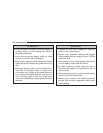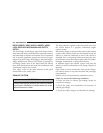
Amount of belt deflection
in (mm)
Standard value Used belt New belt
A .26 to .35
(6.7 to 9.0)
.28 to .33
(7.2 to 8.4)
.17 to .21
(4.4 to 5.3)
B .46 to .60
(11.7 to 15.3)
.49 to .56
(12.5 to 14.3)
.34 to .43
(8.8 to 11.0)
C .43 to .56
(11.0 to 14.3)
.46 to .52
(11.7 to 13.3)
.33 to .41
(8.4 to 10.4)
D .33 to .43
(8.5 to 10.9)
.35 to .40
(9.0 to 10.1)
.24 to .30
(6.2 to 7.6)
WARNING!
Do not check or touch the drive belt with the engine
running, or serious injury may result.
TIMING BELT
The timing belt should be replaced with a new one at the
mileage specified on the scheduled maintenance chart.
TIRES
WARNING!
Driving with tires that are worn or improperly inflated
can result in a collision, and serious or fatal injury.
Tire inflation pressures
Proper tire inflation pressure is essential to the safe and
satisfactory operation of your vehicle. Three primary
areas are affected by improper tire pressure:
1. Safety
Under-inflation increases tire flexing and can result in tire
failure. Over-inflation results in a tire losing its ability to
cushion shock. Objects on the road and potholes could
cause tire damage that may result in tire failure.
2. Economy
Improper inflation pressures can cause uneven wear
patterns to develop across the tire tread. These abnormal
wear patterns will reduce tread life, resulting in a need
for earlier tire replacement.
Under-inflation also increases tire rolling resistance and
results in higher fuel consumption.
334 MAINTENANCE


















